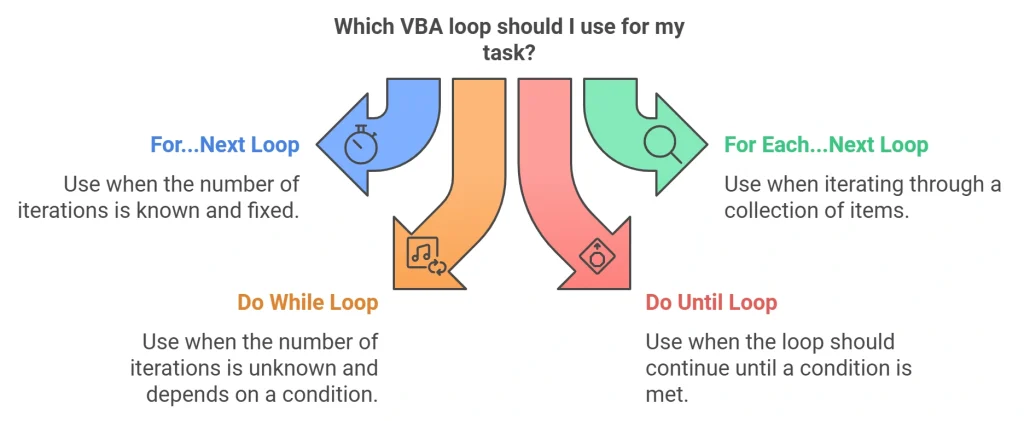Have you ever found yourself repeatedly performing the same task in MS Word, wishing there was an easier way? Whether it’s formatting specific words, applying a style to every heading, or managing document data, repetitive actions can eat up your time. Luckily, with VBA (Visual Basic for Applications), you can use loops to automate these tasks. This makes your work efficient and frees you up for more creative pursuits. Imagine being able to automate all those tedious, time-consuming tasks with just a few lines of code. It’s not only possible, but it’s also easier than you think.
In this blog, we’ll explore how to use loops in VBA to perform repetitive actions in MS Word. For more on using macros to speed up your workflow, check out how to create a macro to insert blocks of text. We’ll break down what VBA loops are, explain how they work, and show practical examples of using them in MS Word. If you want to streamline your workflow, reduce errors, and get your work done faster, this guide is for you. Whether you’re a beginner or a seasoned professional, VBA loops can revolutionize the way you handle repetitive tasks in Word.
What are VBA Loops and Why Should You Use Them?
What are VBA Loops?

VBA loops are structures that repeat a set of actions for a specified number of times or until a specific condition is met. In other words, loops are perfect for tasks that need to be repeated—like formatting every paragraph in a document or making changes to every occurrence of a particular word. Loops are an essential part of programming that enable automation, saving significant time and effort.
Why Use VBA Loops in MS Word?

- Time Saver: Using loops in VBA can save hours of manual work. Instead of manually going through hundreds of lines, you can automate the process and complete it within seconds.
- Error Reduction: Automation reduces the risk of human errors. When tasks are automated, the chances of skipping a step or making a mistake are minimized, resulting in more accurate documents.
- Consistency: Loops help apply consistent changes throughout a document, ensuring professionalism and accuracy. Consistent formatting helps make your documents look clean, professional, and well-organized.
Imagine you have a 100-page document and need to apply formatting to all headings—loops let you automate this instead of manually changing each heading one by one. This kind of efficiency is crucial for anyone who deals with long documents regularly, whether for business, education, or personal projects.
Types of VBA Loops You Can Use in MS Word

There are several types of VBA loops you can use to automate actions in MS Word, and understanding which one to use is essential for efficient automation. Knowing how to select the right loop for your needs can make a big difference in how effectively you can streamline your tasks. You can also learn about using macros to automate text formatting in MS Word to simplify your work.
1. For…Next Loop
The For…Next Loop is used when you know exactly how many times you want the loop to run. This type of loop is great for tasks that need to be repeated a fixed number of times. It allows you to easily iterate through a set number of elements and apply changes.
Example: Applying formatting to the first 10 paragraphs in a document.
For i = 1 To 10
ActiveDocument.Paragraphs(i).Range.Font.Bold = True
Next iWith the For…Next Loop, you can make precise changes to a specific range of items in your document. For example, formatting only the first 10 paragraphs or changing the style of the first 5 tables. This makes it ideal for situations where you need predictable, controlled automation.
2. For Each…Next Loop
The For Each…Next Loop is used when you want to repeat an action for each item in a collection. In MS Word, you can use this to iterate through paragraphs, sentences, words, or even shapes in a document. This loop is especially useful when working with collections where you need to make changes to each item, regardless of the total number.
Example: Making each heading in a document bold.
Dim para As Paragraph
For Each para In ActiveDocument.Paragraphs
If para.Range.Style = "Heading 1" Then
para.Range.Font.Bold = True
End If
Next paraThe For Each…Next Loop is perfect for applying changes uniformly across different parts of your document. If you want to dive deeper, you can explore how to edit macro code in MS Word for more advanced automation. You can easily identify elements, such as paragraphs styled as headings, and apply the desired formatting to each one. This is particularly useful when working with documents that have varied content but require consistent styling for certain sections.
3. Do While Loop
The Do While Loop runs as long as a certain condition is true. This type of loop is useful when the number of iterations isn’t known beforehand. It keeps running until a specified condition is no longer met, giving you flexibility for more complex automation.
Example: Removing all instances of a specific word from a document.
Do While ActiveDocument.Content.Find.Execute(FindText:="specific word")
Selection.Delete
LoopThe Do While Loop is ideal for tasks where the number of repetitions isn’t known in advance, such as searching for and deleting all occurrences of a word. This loop gives you control over tasks that depend on conditions being true, allowing you to continue until the criteria are no longer met.
4. Do Until Loop
The Do Until Loop will keep running until a specific condition is met. This loop is effective for automating tasks that require stopping only when a certain condition is fulfilled. It ensures that your script keeps executing until the desired result is achieved.
Example: Looping through paragraphs until you reach a specific word.
Dim para As Paragraph
For Each para In ActiveDocument.Paragraphs
If InStr(para.Range.Text, "STOP") > 0 Then Exit For
para.Range.Font.Italic = True
Next paraThe Do Until Loop provides a great deal of flexibility when working with documents where you need to make changes up to a certain point. It ensures that the task will continue until a specific goal is reached, making it very useful for documents with unpredictable content.
Practical Examples: How to Use VBA Loops in MS Word
1. Change Font Size of All Paragraphs
If you need to adjust the font size of every paragraph in your document, you can use a For Each…Next Loop. This can be extremely useful if you have a long document with inconsistent font sizes and you want to standardize them.
Dim para As Paragraph
For Each para In ActiveDocument.Paragraphs
para.Range.Font.Size = 12
Next paraWith this loop, you can ensure that every paragraph in your document has a uniform font size, creating a cleaner, more professional look.
2. Highlight Specific Words in the Document
Sometimes, you may need to highlight every occurrence of a specific word in your document to make it stand out. You can use a Do While Loop to achieve this.
Do While ActiveDocument.Content.Find.Execute(FindText:="important")
Selection.Range.HighlightColorIndex = wdYellow
Selection.MoveRight
LoopThis loop will find each occurrence of the word “important” and apply a yellow highlight, making it easier for readers to locate key information.
3. Add Headers to All Sections
If your document is divided into multiple sections and you want to add the same header to each section, you can use a For Each Loop to automate this process.
Dim sec As Section
For Each sec In ActiveDocument.Sections
sec.Headers(wdHeaderFooterPrimary).Range.Text = "Confidential Document"
Next secThis code will add a header with the text “Confidential Document” to every section in your document, ensuring consistency throughout.
4. Format All Headings Consistently
Imagine you have a document with dozens of headings, and you need them to all be bold, underlined, and in a specific color. You can use a For Each…Next Loop to automate this task.
Dim para As Paragraph
For Each para In ActiveDocument.Paragraphs
If para.Range.Style = "Heading 1" Then
para.Range.Font.Bold = True
para.Range.Font.Underline = wdUnderlineSingle
para.Range.Font.Color = wdColorBlue
End If
Next paraThis example shows how easy it is to maintain a professional look across your entire document. Consistent formatting is key to making documents easy to read and visually appealing, and using VBA loops can ensure that every heading is treated exactly the same.
5. Find and Replace Across an Entire Document
Need to replace a specific term throughout a lengthy document? Using a Do While Loop, you can make the task effortless.
Do While ActiveDocument.Content.Find.Execute(FindText:="OldTerm")
Selection.TypeText Text:="NewTerm"
Selection.MoveRight
LoopThis example is a huge time saver when working with large documents or frequently updated templates. Instead of manually finding and replacing every instance, the loop takes care of it automatically, ensuring that no occurrences are missed.
6. Insert Page Numbers in Multiple Sections
If you want to add page numbers to multiple sections of your document, you can use a For Loop to do this easily.
Dim sec As Section
For Each sec In ActiveDocument.Sections
sec.Headers(wdHeaderFooterPrimary).PageNumbers.Add
Next secThis code allows you to automate page numbering across various sections in your document, ensuring consistency. It’s particularly useful in complex documents like reports or books, where different sections need uniform page numbering.
Tips for Using VBA Loops Efficiently
- Use Comments: Add comments to your code to understand what each part is doing, especially in complex loops. Comments can be lifesavers when you revisit code after some time or share it with others.
- Avoid Infinite Loops: Ensure your loop will eventually meet a condition to stop. An infinite loop can crash MS Word, potentially leading to lost data or requiring a restart.
- Test in Small Sections: Run your VBA script in a small section of the document first to ensure everything works as expected and to prevent accidental changes to the entire document. Testing in small sections can help identify any bugs or unintended effects early on.
- Backup Your Document: Before running a macro that includes loops, make sure to save a copy of your document. This way, if anything goes wrong, you won’t lose your data.
Common Questions About Using VBA Loops in MS Word
1. Is it hard to learn VBA loops for MS Word?
Not at all! VBA loops might seem intimidating, but they are quite easy to understand once you practice a bit. Start with simple tasks like formatting paragraphs and gradually move on to more complex automation. The key is to practice regularly and experiment with different types of loops.
2. Can I use VBA loops without coding experience?
Yes! MS Word allows you to record macros, which essentially write the code for you. You can then review the recorded code to learn how it works and tweak it as needed. This is a great way to familiarize yourself with the basics of VBA.
3. What types of tasks can I automate with VBA loops in MS Word?
With VBA loops, you can automate repetitive tasks like formatting, inserting text, adding page numbers, or performing find-and-replace actions across the entire document. The possibilities are virtually limitless, making VBA an incredibly versatile tool for productivity.
4. Will using VBA loops save me time?
Absolutely! Using VBA loops can save hours of work, especially if you’re handling lengthy documents or tasks that require applying the same action repeatedly. Once you’ve set up the loop, you can let it do the heavy lifting for you.
5. Can I use VBA loops in other Microsoft Office applications?
Yes, VBA is not only for MS Word but also works in Excel, PowerPoint, and Outlook. The concept of loops can be applied to automate repetitive tasks across all Microsoft Office applications, making VBA a powerful tool for anyone using the Office suite.
Conclusion
VBA loops in MS Word are powerful tools that can save you time, reduce repetitive work, and make your workflow more efficient. For more detailed guidance, you can visit the official Microsoft documentation on using loops in VBA.
Whether you’re formatting headings, replacing terms, or inserting page numbers, loops help you achieve consistency and speed in your documents. Start by experimenting with simple loops, and as you grow more comfortable, you’ll be able to tackle increasingly complex tasks. Automation can significantly enhance your productivity and make working with MS Word far more enjoyable.
Ready to transform your MS Word experience? Try using VBA loops today, and see how much time and effort you can save while achieving consistent, professional results. The more you practice, the more you’ll unlock the full potential of VBA to automate your work and streamline your tasks, leaving you more time for creativity and critical thinking.

